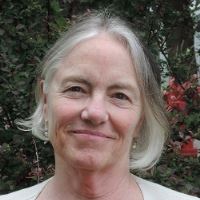Commentary on John 9:1-41
This story, filled with strange conflicted sayings, involves a healer who gives a blind man sight and then disappears.
He leaves behind questions that the other characters struggle to answer by asking the wrong question. Everyone in the scene—the religious leaders, the parents of the now-sighted man, and the man himself—speak without connecting with each other.
When the religious leaders ask for the fifth time a question using the word “how”—“How did he open your eyes?”—we see that they are fixated on method rather than going to the deeper question: Who is this healer? (Actually, it may be that the “how” questions are meant to obfuscate what they really want to know in order to trip Jesus up.) The formerly blind man answers, in what ends up being one of those rare places in Scripture that is actually comic, whether the religious leaders want to know what Jesus did because they want to become his disciples. We know they are not interested in becoming his followers. They want to trap a threatening rabbi (teacher) and healer who confronts them with their unmerciful rules, like not being allowed to do a holy work on the Sabbath.
The religious leaders even turn against the now-sighted man with disgust that he, a sinner, would deign to tell them how to think about Jesus. You can almost smell the vainglory dripping off these affronted religious types. We know them in our own time. They often get caught offending in just the way they accuse others of sinning.
Jesus’ absence for most of the story gives the ignorant and threatened people time to try to find someone who will blame Jesus rather than giving him credit for a good gift. When he reappears, he perfectly depicts in double meaning the point of his healing: “I came into this world … so that those who do not see may see” (John 9:39).
Giving sight to a blind man, repeated references to light––these images are also found in the other readings for this day so that the preacher might be drawn to the role of vision in how we live. In the readings appointed to accompany the healing of the blind man, we are told that we see “as mortals see … the Lord looks on the heart” (1 Samuel 16:7). In the Epistle (Ephesians 5:8-14), light exposes what is done in secret, making visible what was not visible, bringing out the fruits of what is “good and right and true.” We need light to illumine our way, because we cannot see with our eyes in the dark. This is true for all people, all races, and for most creatures (exceptions are some fantastical beings that live in the deepest, darkest parts of the oceans).
Abiding “in darkness”—as the Epistle contrasts that place with being “in the Lord”—has to do with orientation, perspective, and goals. Consider what you learn from a visit to an underground mine, for instance, when the guide turns off the lights for a brief moment.
- You are oriented only to yourself—the clammy humidity on your skin that occurs far underground, hearing or feeling the beat of your heart.
- You can no longer see anyone else in the group.
- You alone are important; there is no larger picture.
- You are focused on the moment, on temporal safety.
(OK this may be a little dramatic, but if you’ve been in a mine without light, you know I’m telling the truth!)
On the other hand, when you are living “in the Lord,” the scope enlarges.
- You can see other people.
- Community becomes possible.
- You step with confidence into the unknown.
- You comprehend the landscape, the big picture.
These are conditions for an orientation that can lead to “what is pleasing to the Lord” (Ephesians 5:10).
When Jesus returns to the story at the end, he pulls out from God’s word the deeper meaning of having vision. He enlarges the meaning of the light that God gives so that it becomes a kind of interior seeing. Having vision becomes a way to connect with others.
The healed man doesn’t get caught up in the obfuscating questions of the religious leaders like whether Jesus is a sinner. The healed man says what he knows to be the flat truth: he healed me. And he is gutsy. He sounds exasperated at the religious leaders when they want to hear it again and he says, “I have told you already, and you would not listen.” His vision has brought him a clarity that we might all admire. Vision brings wisdom.
This story has all the people you can find in any religious or secular group:
- the self-righteous powerful,
- the rubbernecking neighbors,
- the ones who want to turn a blind eye, and
- the ones who try to avoid getting involved.
The only one who truly receives light is the blind man. He’s the only one who is healed. He’s the only one who names Jesus appropriately.
The story of the blind man’s healing in John can be recounted in three parts:
- Jesus comes and heals the man born blind.
- Everybody is in a dither trying to figure out what happened.
- Jesus comes again to the healed man when he is kicked out of the community.
This movement of events mirrors our world in every age:
- Jesus came.
- We wonder what happened and argue about it.
- Jesus comes to us … again and again … with healing.
Jesus, the light of the world, is a mystery, except that while the whole world around the blind man is confused, the blind man is quietly abandoned by everyone but Jesus.
Finally, notice Jesus’ most telling action. Jesus comes to the man in his blindness and gives him vision. He does not quiz the blind man about anything. Only later, when Jesus returns, does he use the word “believe.” His healing makes no conditions.


March 22, 2020